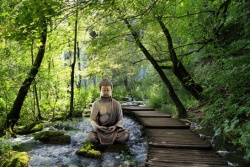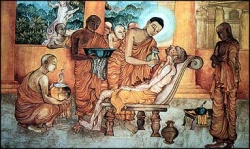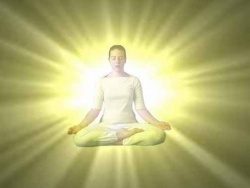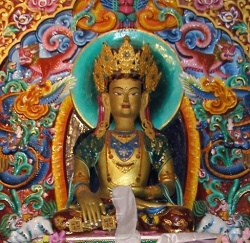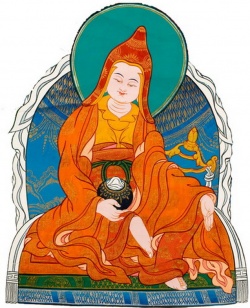Tulkus and Lineage
Lord Buddha Shakyamuni lived over 2,500 years ago in what is now India and Nepal. Seeing the suffering of the world, he sought out and discovered a way to end this suffering that is endured by all sentient beings, the suffering of continuous death and rebirth since time out of mind with no hope of escape. He spent the majority of his life teaching this path, and after his life was over, those disciples remembered his teachings and passed them down from generation to generation. Eventually all the major schools and traditions of Buddhism that we see in the world today were developed. All trace their roots to the Buddha.
During his lifetime, the Buddha is said to have turned the Wheel of Dharma (the teachings) three times. First he taught the Four Noble Truths of suffering, the cause of suffering, the ending of suffering, and the path leading to the end of suffering. These teachings form the basis of the Theravadan schools of Buddhism. In the second turning of the Wheel he taught the perfection of wisdom, or the Prajña Paramita, which formed the basis of the Mahayana schools of Buddhism. In the final turning of the Wheel, he taught the doctrine of absolute truth.
Today, all one has to do is make a search of the internet to find a virtual cottage industry of gossip and accusations against virtually every living (and many dead) Buddhist teachers, not just from Tibetan Buddhism, but every branch of Buddhism.
Buddhist teachers, in particular those associated with Tibetan Buddhism, work to break the student out of their old, tired habitual tendencies, tendencies that have developed over countless lifetimes and that keep the student trapped in endless rounds of life, death, and rebirth. Unless the student can break out of these habituated tendencies, they will never know liberation from this cycle. This is the method that the Buddha taught.
There are some people who feed off such gossip and accusations, delighting in them, feeling that they make themselves look blameless and spotless, even though the truth is almost certainly quite the opposite. They begin to think of themselves as better than the teacher, smarter, more “enlightened”. This is, of course, nothing more than delusion. All the person is doing is pumping up their own pathetic ego, meanwhile completely missing the opportunity to rid themselves of the poisons which keep them forever revolving in cyclic existence. They become so infatuated with their own cleverness and “rightness” that they forget that death approaches rapidly, and that they will leave this life totally unprepared for what ensues. It is a sad situation, but one that continues to be widespread in the West.
So, what are the qualities to look for in a qualified Teacher of the Buddhist Teachings? Gyatrul Rinpoche describes the qualified teacher in this way:
“He should have great pure vision, pure perception, and should work solely for the purpose of others. The lama should have abandoned the eight worldly concerns, and without a single concern for this life and for the things of this life, he should direct all efforts towards preparations for future lifetimes. He should be a true holder of a lineage containing the powerful blessings of great realized masters. . . .”
Gyaltrul Rinpoche continues in the same text to describe some things to look out for, such as one who mixes traditions.
“Such a teacher may be clever with words, there may be much to listen to, but the path is upside down. Such a teacher will say he is non-sectarian, saying this is why he’s bringing all these different teachings together (p. 47).”
Emphasizing the importance of all the traditions, Gyaltrul Rinpoche stresses that they should not be mixed; the clarity of the teacher, the teaching, and the lineage is essential because of the confusion in which we sentient beings find ourselves.
“You are already in a state of deep-rooted confusion. When a teacher doesn’t lay out a path clearly, when he can’t document its origins, its lineages, and has no proof of its validity, when he mixes traditions, creating his own path, and tries to convince you of its validity, confusion increases. On the other hand, if a teacher is very clear and teaches in a straightforward way: This is our tradition; this is the origin, these are the principles, this is the path, no matter what religion or what tradition, keeping it in its proper context, this makes things much easier for the disciple.” (p.49)
The Great Master of Oddiyana, Padmasambhava warns: “Not to examine the teacher is like drinking poison.”
Lineage is both delimited and defined by accomplishment. One cannot be said to “hold” a lineage in the absence of actual accomplishment. And that is where we see the one-sidedness. One does not “point to” one’s teachers; one’s teachers point to the ones they recognize as accomplished. Conferring of these very titles by Lineage Masters represents that recognition of accomplishment.
Students in the West who have only been exposed to Buddhism for a relatively short time and who have little familiarity with the arcane practices and traditions of Tibetan Buddhism in particular, the idea of lineage and Tulkus seems foreign and somehow suspicious. The idea of teachers being reborn again and again to guide their students towards liberation seems impossible. Some even see it as a way of ensuring that power remains in the hands of a select few who control – or controlled – a large percentage of Tibet’s wealth and land. Is this really the case? Is Lineage and the Tulku system that supports it of any value in the West? Does it support or obstruct students on their path?
One way to approach this issue would be to imagine what Buddhism would be like without the concept of lineage. Lineage means that the teachings are passed directly from master to student, and it is never done without demonstrable accomplishment on the part of the student. Once the student receives the transmission, he or she becomes a lineage holder fully qualified not only to teach but to pass along the teachings to his or her student(s). It is not a light responsibility. Without integrity, there would be no lineage.
Without this direct transmission from teacher to student, the teachings would soon become corrupted and fade away. They would lose their vitality, their freshness. They would just become another dry, stale philosophy tucked away in old books in libraries. No one would understand their essence, and no one would benefit from studying them. Eventually the teachings would become a mere footnote in history or lost altogether.
Lineage then is necessary to preserve the essence and purity of the teachings, to prevent them from being distorted and perverted into something other than what they were intended to be and from being used as excuses to control and destroy others. Those who criticize the idea of lineage in Buddhism and the vital role that Tulkus play in preserving that lineage have not examined its value and necessity. Rather they would follow the path of self-indulgence and delusion, celebrating their own egos at the expense of true enlightenment.
Tulku is often translated into English as “reincarnate lama”, but its meaning is a bit more profound than that. The Tibetan word “Tulku” is a translation of the Sanskrit word “Nirmanakaya”. Nirmanakaya is one of the so-called three bodies of the Buddha (kaya means body and nirmana means created, so “created body”). The other two bodies of the Buddha are the Sambhogakaya (“bliss body”) and Dharmakaya (“truth body”). They represent the enlightened body, speech and mind of the Buddha. In other words, they represent the three ways in which the Buddha displays his enlightened activity.
Therefore the Nirmanakaya form of the Buddha is the manifestation of enlightenment on the physical plane. Without this manifestation, such as Buddha Shakyamuni, there would be no way for ordinary sentient beings to even know that there is such a thing as enlightenment, much less have a path to follow so that they also could attain that state.
Tulkus, however, do not have to be fully enlightened beings. Rather a Tulku is considered to be a reincarnation of a Buddhist master who has achieved a level of attainment and has developed the mind of Bodhicitta, or ultimate compassion, and because of the compassion he or she has for the suffering of sentient beings has taken a vow to return to this life again and again to help beings attain enlightenment, the end of suffering. When most sentient beings die, they are blown by the winds of karma to their next life, which may be in any of the six realms of existence (hell realm, hungry ghost realm, animal realm, human realm, jealous god realm or god realm) and in conditions ranging from extreme suffering to extreme bliss. Tulkus, however, are able to choose their next incarnation because of their pure motivation and intent to benefit others.
The Tulku system is a uniquely Tibetan institution (although it is also found in other countries which follow the Vajrayana form of Buddhism, such as Mongolia, Bhutan, Sikkim or Ladakh). The first Tulku to be recognized was the Second Karmapa, Karma Pakshi, who lived from 1206-1283 c.e., who was identified as the reincarnation of the First Karmapa, Dusum Khyenpa, who founded the Karma Kagyu tradition. Since that time literally thousands of Tulkus have been recognized, both in the Asian countries in which Vajrayana has been traditionally practiced and more recently in countries into which Vajrayana has spread following the diaspora caused by the Chinese invasion of Tibet.
Generally a Tulku is recognized by another Tulku (or Tulkus) as only a being with a high level of attainment has the power to accurately judge whether someone has the qualities necessary to be recognized. Such recognition is not taken lightly. Tulkus in Tibet usually enjoyed a great deal of power and often wealth, and because of that, there were cases where Tulkus were recognized because of political expediency more than any actual authentic recognition of their spiritual attainment. Such instances are unfortunate, but it is to be expected whenever ordinary sentient are involved. However, when the recognition is done by an authentic master or a Living Buddha (one who has attained ultimate liberation), then the recognition may be trusted.
Traditionally a Tulku was found at an early age and had to be pass various tests in order to be fully recognized. For example, the testing lama may lay out three ritual implements, such as a mala (prayer beads) or a begging bowl, one of which belonged to the former incarnation. If the child chose the correct item, that was an indication that he was a good candidate. After that an oracle was usually consulted as the Tibetans made few important decisions without such a consultation. If the oracle agreed that the child was indeed the Tulku of the former incarnation, and if the head of the lineage (and often the Dalai Lama) agreed, then the child would be officially recognized. Following that, the child would usually be enthroned. This meant that the child was fully authorized to teach in the tradition of that particular lineage. Once recognized as a Tulku, and given responsibility to teach, it is not something that can be withdrawn, as it is a recognition of who they are.
In the case of Jetsunma Ahkön Lhamo, Spiritual Director and Teacher for Kunzang Palyul Choling (www.tara.org) recognition occurred at a much older age than was traditional in Tibet. It also involved the recognition of a woman, a Western woman nonetheless, whereas in Tibet this recognition was almost always a male. Jetsunma had also no formal training in Buddhism, teaching directly from her mind. Such recognition caused some controversy because of its nontraditional aspects. Yet His Holiness Penor Rinpoche, who was widely venerated as a Living Buddha, was adamant in his recognition, and he was supported by His Holiness Dilgo Khyentse Rinpoche, also a former Supreme Head of the Nyingma tradition, and the Second Dzongnang Jampal Lodro Rinpoche, the most senior Palyul Tulku. It was in turn confirmed by the Dalai Lama.
Recognition was conferred only after a careful examination by His Holiness of what she was teaching her students as well as interviewing her personally in India. He recognized her because he could see that her teachings would be of benefit to sentient beings. He wrote that he really had no concern whether others would agree with his recognition or whether it would be a popular recognition or any of that. He basically said that he calls them as he sees them and if other people have problems with his decisions, it’s their problem, not his. He continued to enthusiastically support her efforts until the end of his life in 2009. His successor, His Holiness Karma Kuchen Rinpoche, has also stated on numerous occasions that he supports her just as His Holiness Penor Rinpoche did and that her activity and her center must continue.
A Brief History of the Nyingma, http://www.nyingma.com/nyingma%20History.htm
Tantric Art, Then and Now, by Robert Beer. Tricycle Spring 2005
The Divine Madman, by Keith Dowman, Pilgrims Book House, 2000
Great Perfection Buddha in the Palm of the Hand Commentary, Gyatrul Rinpoche, 2000
Stripping the Gurus, by Geoffrey D. Falk, Million Monkeys Press, 2009
The Collected Works of Chögyam Trungpa, Vol. 8, edited by Carolyn R. Gimian, Shambhala, 2004
The Words of My Perfect Teacher, by Patrul Rinpoche, Shambhala Publications, Inc., 1998
